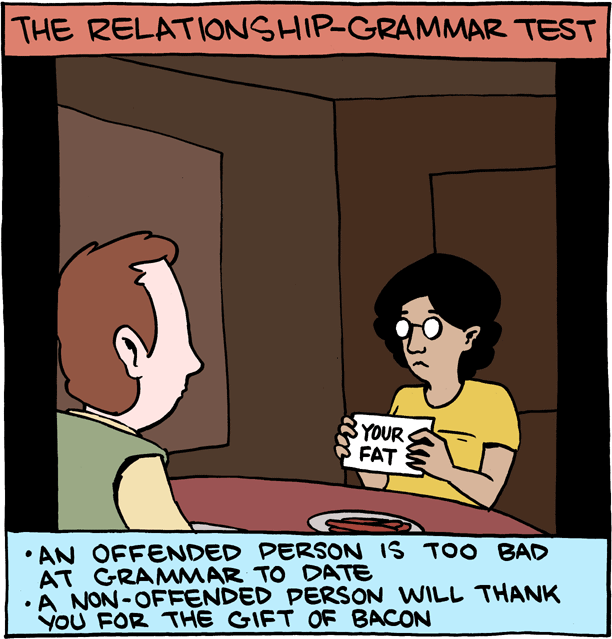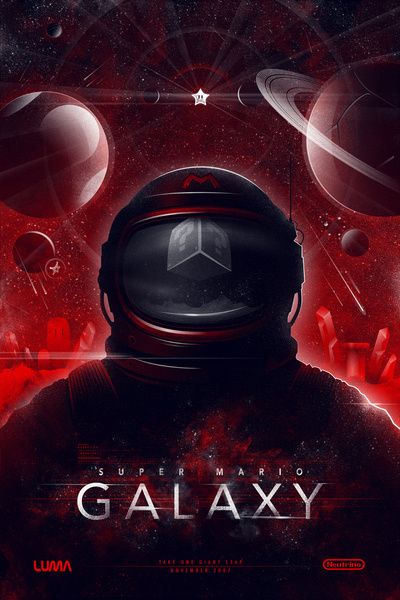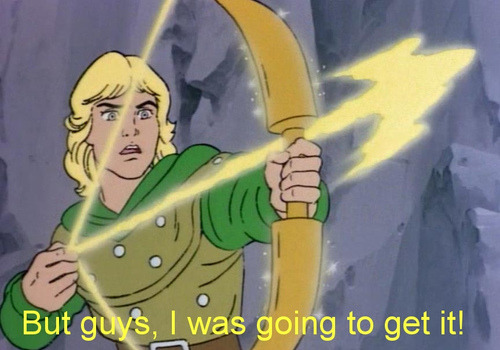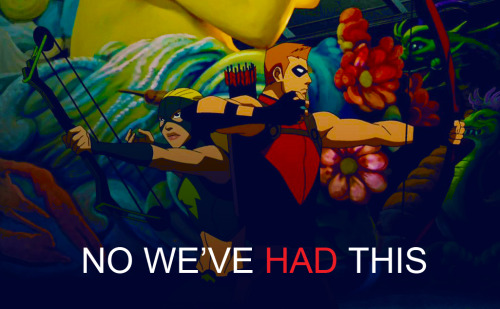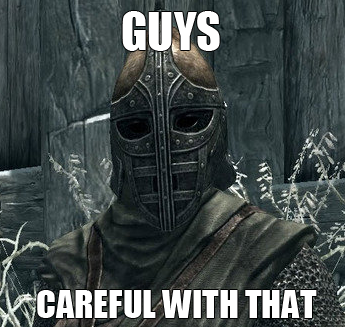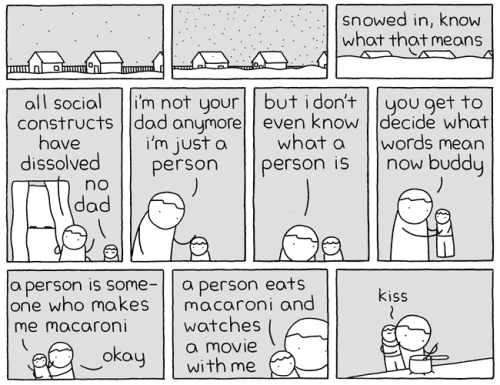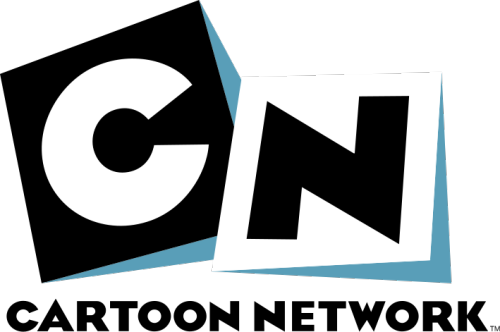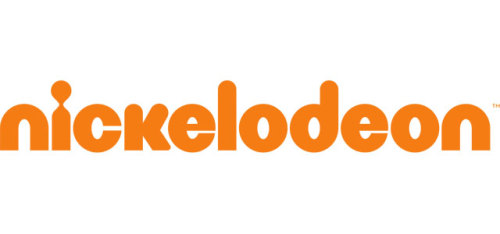Submitted by: smartgray
Posted at: 2012-12-17 16:16:23
See full post and comment: http://9gag.com/gag/6106695
Shared posts
Ice window.
So they told me I need to put a star on my Christmas tree
Submitted by: loukasm
Posted at: 2012-12-17 07:03:33
See full post and comment: http://9gag.com/gag/6099857
Corruption in Brazil: A healthier menu
 SO RARELY has political corruption led to punishment in Brazil that there is an expression for the way scandals peter out. They “end in pizza”, with roughly the same convivial implication as settling differences over a drink. But a particularly brazen scandal has just drawn to a surprisingly disagreeable close for some prominent wrongdoers. The supreme-court trial of the mensalão (big monthly stipend), a scheme for buying votes in Brazil’s Congress that came to light in 2005, ended on December 17th. Of the 38 defendants, 25 were found guilty of charges including corruption, money-laundering and misuse of public funds. Many received stiff sentences and large fines.The supreme court must still write its report on the trial, and hear appeals—though it is unlikely to change its mind. So in 2013 Brazilians should be treated to an unprecedented sight: well-connected politicos behind bars. José Dirceu, who served as chief of staff to the former president, Luiz Inácio Lula da Silva, was sentenced to almost 11 years; Delúbio Soares, former treasurer of the ruling Workers’ Party (PT), got almost nine. Under the penal code, at least part of such...
SO RARELY has political corruption led to punishment in Brazil that there is an expression for the way scandals peter out. They “end in pizza”, with roughly the same convivial implication as settling differences over a drink. But a particularly brazen scandal has just drawn to a surprisingly disagreeable close for some prominent wrongdoers. The supreme-court trial of the mensalão (big monthly stipend), a scheme for buying votes in Brazil’s Congress that came to light in 2005, ended on December 17th. Of the 38 defendants, 25 were found guilty of charges including corruption, money-laundering and misuse of public funds. Many received stiff sentences and large fines.The supreme court must still write its report on the trial, and hear appeals—though it is unlikely to change its mind. So in 2013 Brazilians should be treated to an unprecedented sight: well-connected politicos behind bars. José Dirceu, who served as chief of staff to the former president, Luiz Inácio Lula da Silva, was sentenced to almost 11 years; Delúbio Soares, former treasurer of the ruling Workers’ Party (PT), got almost nine. Under the penal code, at least part of such...
100 Diagrams That Changed the World
A visual history of human sensemaking, from cave paintings to the world wide web.
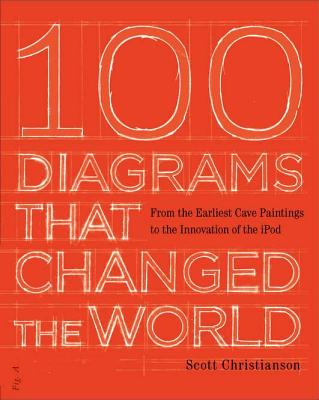 Since the dawn of recorded history, we’ve been using visual depictions to map the Earth, order the heavens, make sense of time, dissect the human body, organize the natural world, perform music, and even concretize abstract concepts like consciousness and love. 100 Diagrams That Changed the World (UK; public library) by investigative journalist and documentarian Scott Christianson chronicles the history of our evolving understanding of the world through humanity’s most groundbreaking sketches, illustrations, and drawings, ranging from cave paintings to The Rosetta Stone to Moses Harris’s color wheel to Tim Berners-Lee’s flowchart for a “mesh” information management system, the original blueprint for the world wide web.
Since the dawn of recorded history, we’ve been using visual depictions to map the Earth, order the heavens, make sense of time, dissect the human body, organize the natural world, perform music, and even concretize abstract concepts like consciousness and love. 100 Diagrams That Changed the World (UK; public library) by investigative journalist and documentarian Scott Christianson chronicles the history of our evolving understanding of the world through humanity’s most groundbreaking sketches, illustrations, and drawings, ranging from cave paintings to The Rosetta Stone to Moses Harris’s color wheel to Tim Berners-Lee’s flowchart for a “mesh” information management system, the original blueprint for the world wide web.
But most noteworthy of all is the way in which these diagrams bespeak an essential part of culture — the awareness that everything builds on what came before, that creativity is combinatorial, and that the most radical innovations harness the cross-pollination of disciplines. Christianson writes in the introduction:
It appears that no great diagram is solely authored by its creator. Most of those described here were the culmination of centuries of accumulated knowledge. Most arose from collaboration (and oftentimes in competition) with others. Each was a product and a reflection of its unique cultural, historical and political environment. Each represented specific preoccupations, interests, and stake holders.
[…]
The great diagrams depicted in the book form the basis for many fields — art, astronomy, cartography, chemistry, mathematics, engineering, history, communications, particle physics, and space travel among others. More often than not, however, their creators — mostly known, but many lost to time — were polymaths who are creating new technologies or breakthroughs by drawing from a potent combination of disciplines. By applying trigonometric methods to the heavens, or by harnessing the movement of the sun and the planets to keep time, they were forging powerful new tools; their diagrams were imbued with synergy.
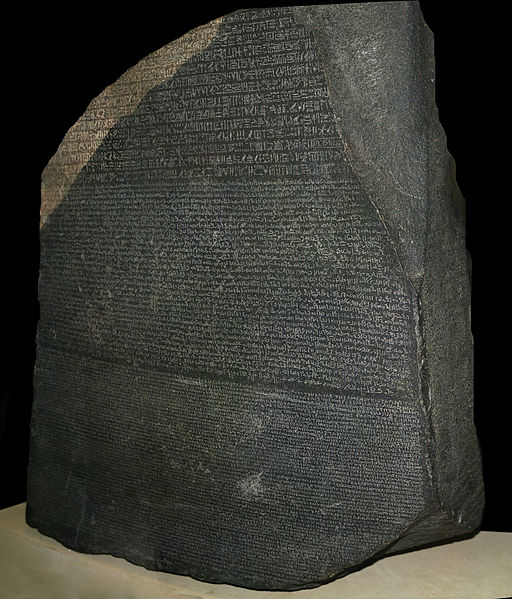
Rosetta Stone (196 BC)
Discovered in 1799, this granite block containing a decree written in three languages allowed Egyptologists to interpret hieroglyphics for the first time -- a language that had been out of use since the fourth century AD.
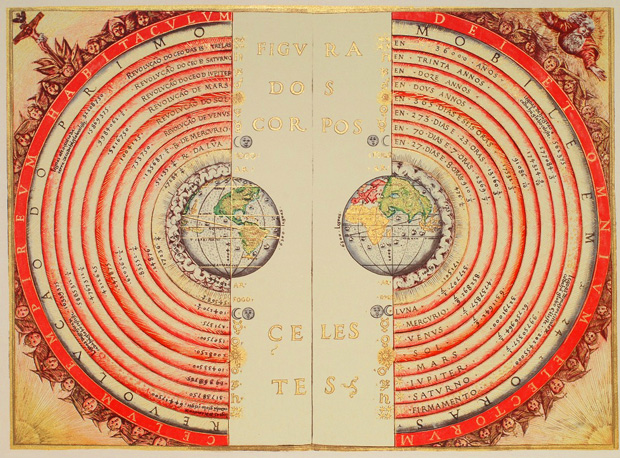
The Ptolemaic System (Claudus Ptolemy, c. AD 140-150)
This 1568 illuminated illustration of the Ptolemaic geocentric system, 'Figura dos Corpos Celestes' (Four Heavenly Bodies), is by the Portuguese cosmographer and cartographer Bartolomeu Velbo.
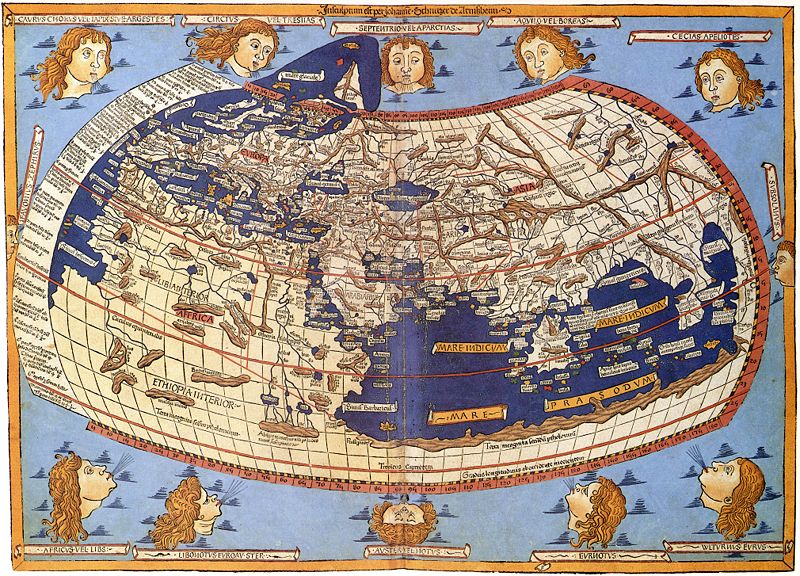
Ptolemy's World Map (Claudius Ptolemy, c. AD 150)
In this 15th-century example of the Ptolemaic world map, the Indian Ocean is enclosed and there is no sea route around the Cape. The 'inhabited' (Old) World is massively inflated.
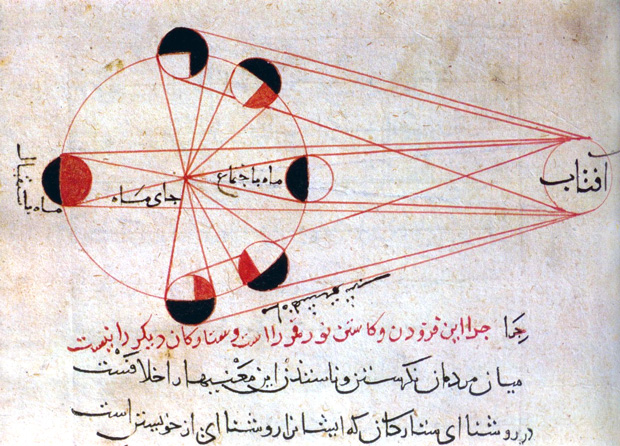
Lunar Eclipse (Abu Rayhan al-Biruni, 1019)
An illustration showing the different phases of the moon from al-Biruni's manuscript copy of his Kitab al-Tafhim (Book of Instruction on the Principles of the Art of Astrology)
Christianson offers a definition:
diagram
From the latin diagramma (figure) from Greek, a figure worked out b lines, plan, from diagraphein, from graphein to write.
First known use of the word: 1619.
- A plan, a sketch, drawing, outline, not necessarily representational, designed to demonstrate or explain something or clarify the relationship existing between the parts of the whole.
- In mathematics, a graphic representation of an algebraic or geometric relationship. A chart or graph.
- A drawing or plan that outlines and explains the parts, operation, etc. of something: a diagram of an engine.

Dante's Divine Comedy (Dante Alighieri, 1308-21)
A 19th-century interpretation of Dante's map of Hell. The level of suffering and wickedness increases on the downward journey through the inferno's nine layers. No original copies of Dante's manuscript survive.
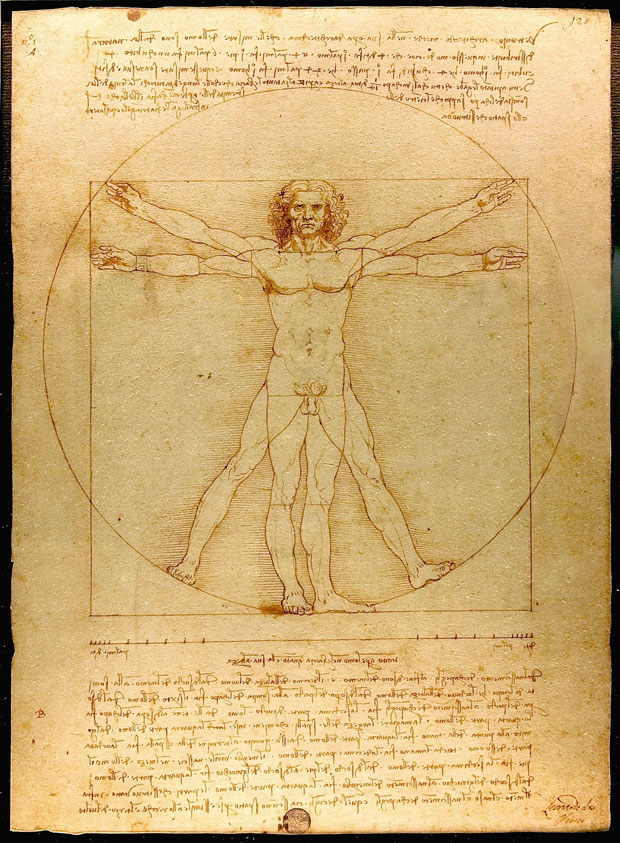
Vitruvian Man (Leonardo da Vinci, c. 1487
This sketch, and the notes that go with it, show how da Vinci understood the proportions of the human body. The head measured from the forehead to the chin was exactly one tenth of the total height, and the outstretched arms were always as wide as the body was tall.
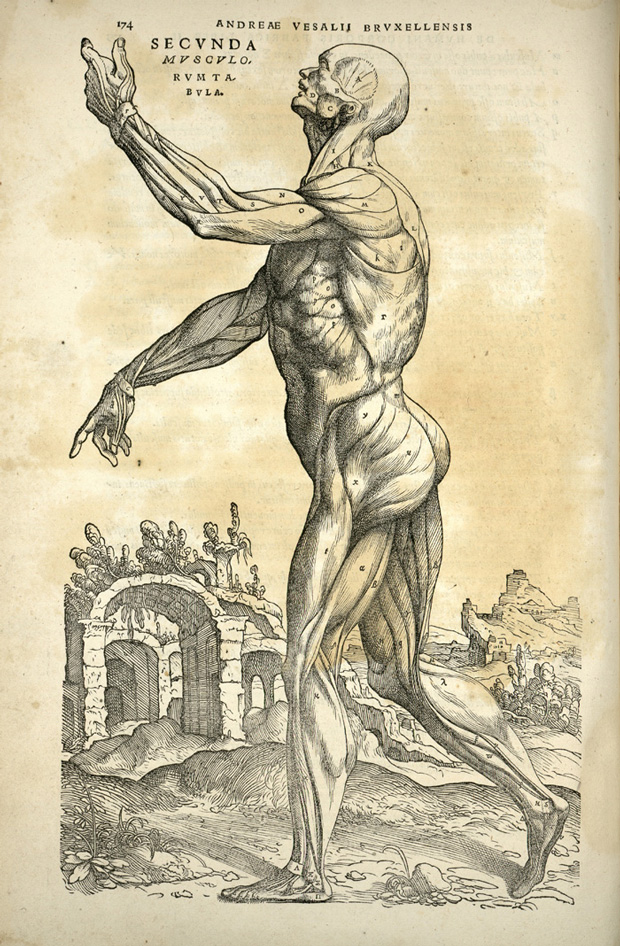
Human Body (Andreas Vesalius, 1543)
Vesalius's revolutionary anatomical treatise, De Humani Corporis Fabrica, shows the dissected body in unusually animated poses. These detailed diagrams are perhaps the most famous illustrations in all of medical history.
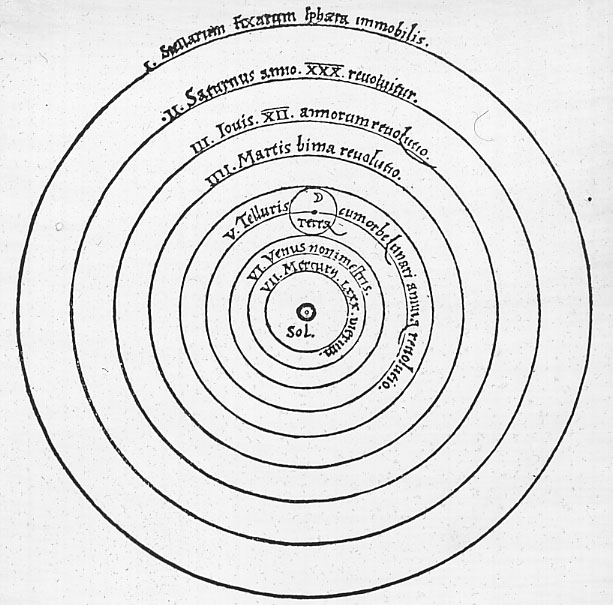
Heliocentric Universe (Nicolaus Copernicus, 1543)
Copernicus's revolutionary view of the universe was crystallized in this simple yet disconcerting line drawing. His heliocentric model -- which placed the Sun and not the Earth and the center of the universe -- contradicted 14th-century beliefs.

The Four Books of Architecture
Palladio's country villas, urban palazzos, and churches combined modern features with classical Roman principles. His designs were hailed as 'the quintessence of High Renaissance calm and harmony.'

Flush Toilet (John Harington, 1596)
The text accompanying Harington's diagram identified A as the 'Cesterne,' D as the 'seate boord,' H as the 'stoole pot,' and L as the 'sluce.' If used correctly, 'your worst privie may be as sweet as your best chamber.'
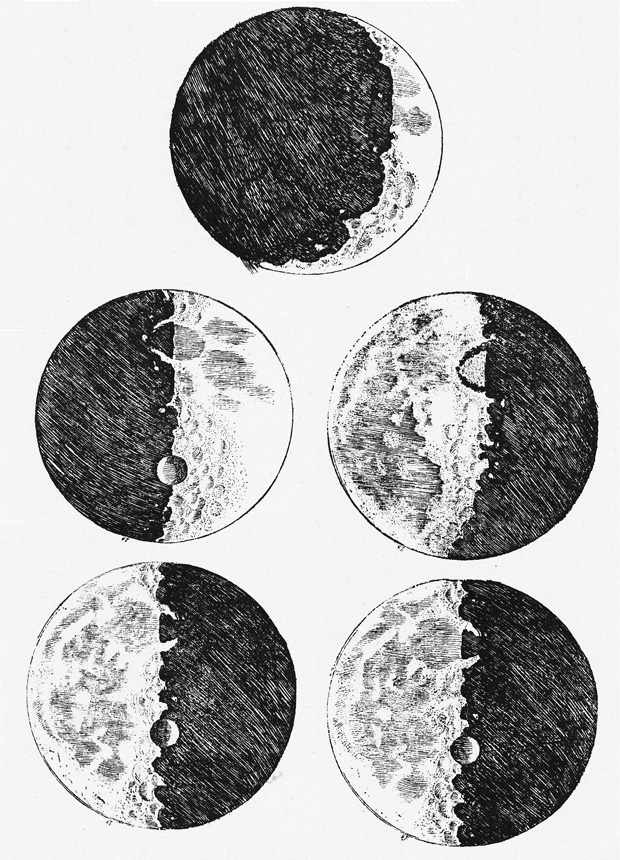
Moon Drawings (Galileo Galilei, 1610)
Aided by his telescope, Galileo's drawings of the moon were a revelation. Until these illustrations were published, the moon was thought to be perfectly smooth and round. Galileo's sketches revealed it to be mountainous and pitted with craters.
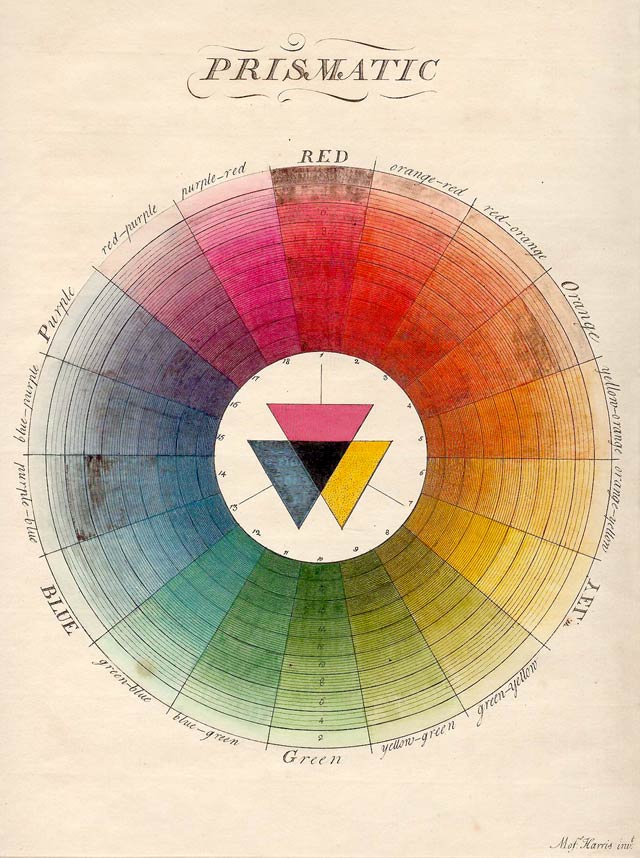
Color Wheel (Moses Harris, 1766)
Moses Harris's chart was the first full-color circle. The 18 colors of his wheel were derived from what he then called the three 'primitive' colors: red, yellow and blue. At the center of the wheel, Harris showed that black is formed by the superimposition of these colors.
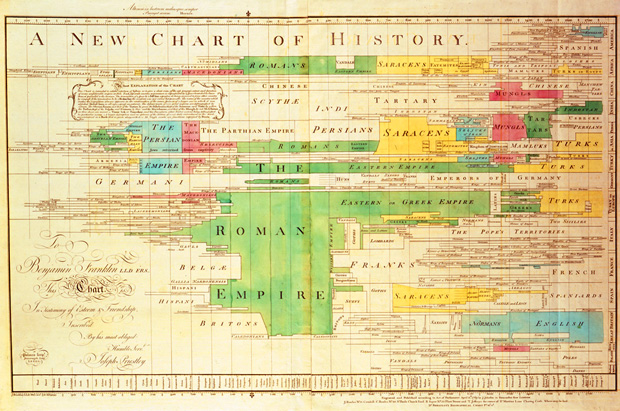
A New Chart of History (Joseph Priestley, 1769)
The regularized distribution of dates on Priestley's chart and its horizontal composition help to emphasize the continuous flow of time. This innovative, colorful timeline allowed students to survey the fates of 78 kingdoms in one chart.
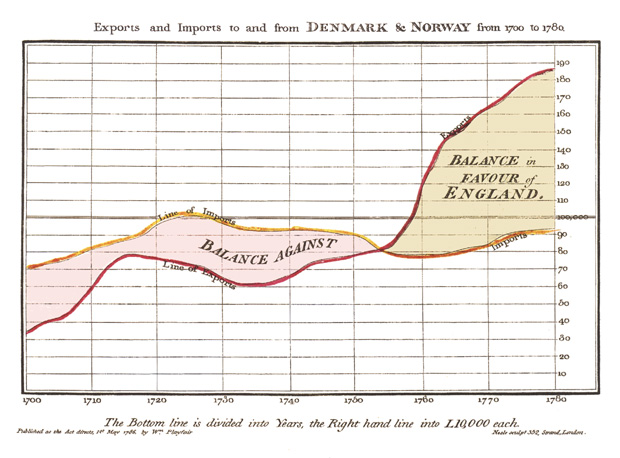
Line Graph (William Playfair, 1786)
William Playfair was the first person to display demographic and economic data in graph form. His clearly drawn, color-coded line graphs show time on the horizontal axis and economic data or quantities on the vertical axis.

Emoticons (Puck Magazine, 1881)
Emoticons made a discreet entrance, arriving in print for the first time in this March 30, 1881 issue of Puck. The small item in the middle of this page gives four examples of 'typographical art' -- joy, melancholy, indifference, and astonishment.
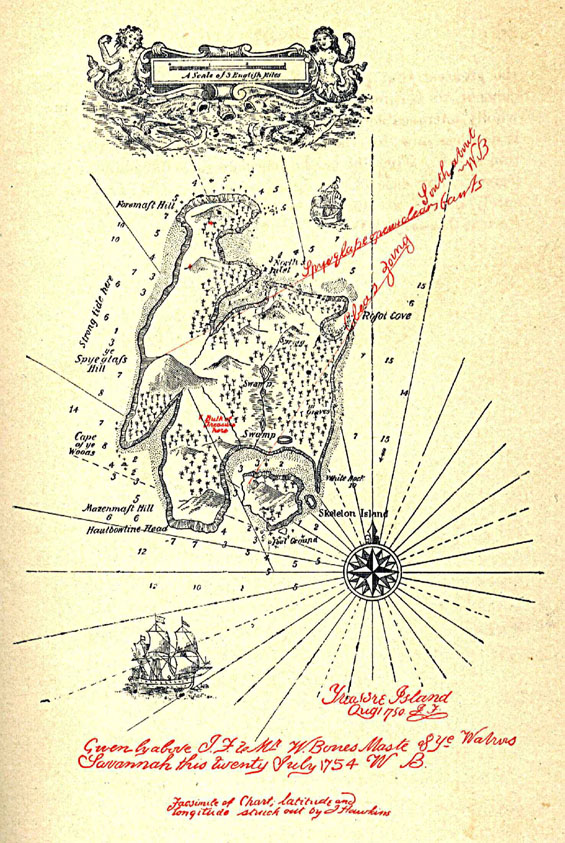
Treasure Island Map (Robert Louis Stevenson, 1883)
While there is no evidence of real pirates ever leaving a 'treasure map' showing where they had buried their stolen goods, with 'X' marking the spot, Stevenson's fictional device has continued to excite generations of children to this day.
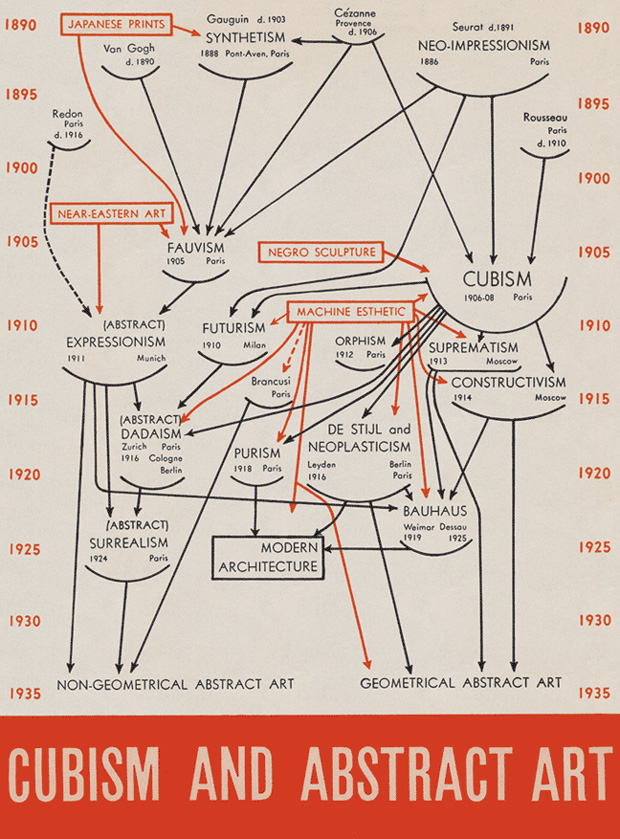
Cubism and Abstract Art (Alfred Barr, 1936)
Barr's striking diagram highlighted the role that cubism had played in the development of modernism. Like the exhibition and book that accompanied it, Barr's diagram was a watershed in the history of 20th-century modernism.
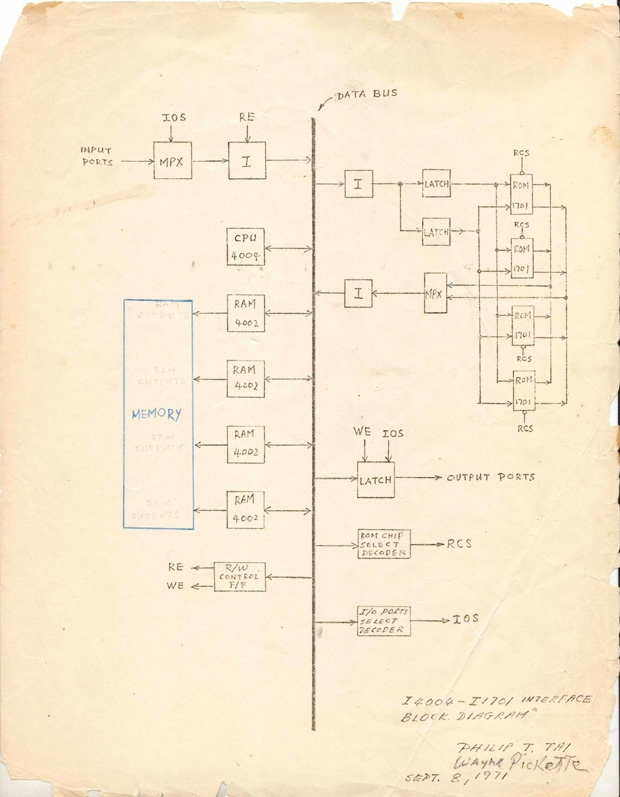
Intel 4004 CPU (Ted Hoff, Stanley Mazor, Masatoshi Shima, Federico Faggin, Philip Tai, and Wayne Pickette, 1971)
Wayne Pickette suggested that Intel could use a 'computer on a board' for one of their projects with the Japanese company Busicom. Pickette drew this diagram with Philip Tai for the 4004 demonstration board.
Complement 100 Diagrams That Changed the World with 17 equations that changed the world and the fantastic Cartographies of Time.
Thanks, Kirstin
Donating = Loving
In 2012, bringing you (ad-free) Brain Pickings took more than 5,000 hours. If you found any joy and stimulation here this year, please consider becoming a Member and supporting with a recurring monthly donation of your choosing, between a cup of coffee and a fancy dinner:
| ♥ $10 / month♥ $3 / month♥ $25 / month♥ $50 / month♥ $100 / month |
![]()
You can also become a one-time patron with a single donation in any amount:
 Brain Pickings has a free weekly newsletter and people say it’s cool. It comes out on Sundays and offers the week’s best articles. Here’s what to expect. Like? Sign up.
Brain Pickings has a free weekly newsletter and people say it’s cool. It comes out on Sundays and offers the week’s best articles. Here’s what to expect. Like? Sign up.
Brain Pickings takes 450+ hours a month to curate and edit across the different platforms, and remains banner-free. If it brings you any joy and inspiration, please consider a modest donation – it lets me know I'm doing something right.

A lógica, os paradoxos e as falácias
 Estou lendo o livro Ah, apanhei-te, de Martin Gardner, uma divertida obra sobre lógica, paradoxos e falácias.
Estou lendo o livro Ah, apanhei-te, de Martin Gardner, uma divertida obra sobre lógica, paradoxos e falácias.Um dos capítulos mais divertidos trata dos paradoxos.
O mais famoso deles é o paradoxo do mentiroso. Um cretense diz: "Todo cretense é mentiroso". Como cretense, ele deve estar mentindo, mas se estiver mentindo, está dizendo a verdade.
Outro exemplo é da cidade em que todos os viajantes deveriam dizer o que fariam lá. Quem mentisse seria enforcada. Um dia um viajante chegou e os guardas lhe perguntaram: "O que veio fazer aqui?" e ele: "Eu vim ser enforcado". Se ele for enforcado, ele disse a verdade, portanto não era mentiroso e não poderia ser enforcado.
Outro exemplo interessante, dentro da teoria dos conjuntos: um barbeiro coloca uma placa na frente de seu estabelecimento com os dizeres "Eu barbeio todos os homens desta cidade que não se barbeiam sozinhos". Quem barbeia esse barbeiro? Não pode ser ele, e não pode ser outro. Uma solução apresentada por amigos do Twitter foi: o barbeiro é uma mulher e, portanto não precisa ser barbeado.
Vending machine auction markets in everything
…ecoATM, a firm based in San Diego…has devised and deployed in several American cities a series of ATM-like devices that will automatically analyse your mobile phone, MP3 player or phone charger, and then make you an offer for it. These machines will give you cash in hand or, if you prefer, send the money as a donation to the charity of your choice. The hope is that this hassle-free approach will appeal to people who can’t be bothered to recycle their old phone when buying a new one.
After taking fingerprints and driving-licence details (to discourage crooks from using them to fence stolen goods), ecoATM’s kiosks employ a mixture of computer vision and electronic testing (they will automatically present users with the correct cable and connector) to perform a trick that even the most committed gadget fan might struggle with—telling apart each of the thousands of models of mobile phones, chargers and MP3 players that now exist. They can even make a reasonable guess about how well-used (or damaged) a device is, which can affect its resale value. Any mistakes the machine does make are logged and used to improve accuracy in future.
Once the device on offer has been identified, the kiosk then enters it into an electronic auction. Interested parties bid, and a price is struck in seconds. This auction is the key to ecoATM’s business model, because it means the firm is acting as a broker, rather than carrying a stock of second-hand equipment which it then has to sell. If the owner of the equipment accepts the offer, the kiosk swallows the device and spits out the money.
Really. The article is here.
I said pixel art, my grandma showed me this
Submitted by: rodyster
Posted at: 2012-12-25 23:38:56
See full post and comment: http://9gag.com/gag/6172495
Typical Tourist Photo
Submitted by: madeyoulol
Posted at: 2012-12-24 17:27:03
See full post and comment: http://9gag.com/gag/6163052
The Boson Apocalypse
If the world ends today, at least it won’t do so without three identical photons having been used to sample from a probability distribution defined in terms of the permanents of 3×3 matrices, thereby demonstrating the Aaronson-Arkhipov BosonSampling protocol. And the results were obtained by no fewer than four independent experimental groups, some of whom have now published in Science. One of the groups is based in Brisbane, Australia, one in Oxford, one in Vienna, and one in Rome; they coordinated to release their results the same day. That’s right, the number of papers (4) that these groups managed to choreograph to appear simultaneously actually exceeds the number of photons that they so managed (3). The Brisbane group was even generous enough to ask me to coauthor: I haven’t been within 10,000 miles of their lab, but I did try to make myself useful to them as a “complexity theory consultant.”
Here are links to the four experimental BosonSampling papers released in the past week:
- Experimental BosonSampling by Broome et al. (Brisbane)
- Experimental Boson Sampling by Tillmann et al. (Vienna)
- Experimental Boson Sampling by Walmsley et al. (Oxford)
- Experimental boson sampling in arbitrary integrated photonic circuits by Crespi et al. (Italy)
For those who want to know the theoretical background to this work:
- My and Alex’s original 100-page BosonSampling paper (to appear soon in the journal Theory of Computing)
- The 10-page STOC’2011 version of our paper
- My PowerPoint slides
- Alex’s slides
- Theoretical Computer Science StackExchange question and answer
- Gil Kalai’s blog post
- Old Shtetl-Optimized post
For those just tuning in, here are some popular-level articles about BosonSampling:
- Larry Hardesty’s MIT News article (from last year)
- University of Queensland press release
- Victorian counting device gets speedy quantum makeover (this week, from New Scientist; the article is not bad except that it ought to credit Alex Arkhipov)
- New Form of Quantum Computation Promises Showdown with Ordinary Computers, by Adrian Cho (from Science)
I’ll be happy to answer further questions in the comments; for now, here’s a brief FAQ:
Q: Why do you need photons in particular for these experiments?
A: What we need is identical bosons, whose transition amplitudes are given by the permanents of matrices. If it were practical to do this experiment with Higgs bosons, they would work too! But photons are more readily available.
Q: But a BosonSampling device isn’t really a “computer,” is it?
A: It depends what you mean by “computer”! If you mean a physical system that you load input into, let evolve according to the laws of physics, then measure to get an answer to a well-defined mathematical problem, then sure, it’s a computer! The only question is whether it’s a useful computer. We don’t believe it can be used as a universal quantum computer—or even, for that matter, as a universal classical computer. More than that, Alex and I weren’t able to show that solving the BosonSampling problem has any practical use for anything. However, we did manage to amass evidence that, despite being useless, the BosonSampling problem is also hard (at least for a classical computer). And for us, the hardness of classical simulation was the entire point.
Q: So, these experiments reported in Science this week have done something that no classical computer could feasibly simulate?
A: No, a classical computer can handle the simulation of 3 photons without much—or really, any—difficulty. This is only a first step: before this, the analogous experiment (called the Hong-Ou-Mandel dip) had only ever been performed with 2 photons, for which there’s not even any difference in complexity between the permanent and the determinant (i.e., between bosons and fermions). However, if you could scale this experiment up to about 30 photons, then it’s likely that the experiment would be solving the BosonSampling problem faster than any existing classical computer (though the latter could eventually solve the problem as well). And if you could scale it up to 100 photons, then you might never even know if your experiment was working correctly, because a classical computer would need such an astronomical amount of time to check the results.
Choose Your Superpower

In case you missed it, last week we announce our new store! Hopefully this is just the start. We’re going to try to add lots of other good stuff regularly! Thanks for all the support and encouragement! Also, feel free to continue letting us know if there’s anything in particular you’d like to see added in the shop.
Tweet50% da receita de aplicações mobile vão para VINTE E CINCO desenvolvedores

Concentração de renda é bobagem.
Uma das bandeiras vendidas com as App Stores da vida é que qualquer um pode criar um próximo Instagram e ficar rico, mas na realidade a situação é a mesma de ter Word em casa e por isso virar o próximo George R.R. Martin, ou a próxima JK Rowling, se você tiver um mínimo de apego a seus personagens.
É possível? Sim, mas a ferramenta é praticamente irrelevante. Ter acesso a ela fará pouco ou nada de diferença. As App Stores hoje são um ambiente incrivelmente darwinista, grandes estúdios entraram pesado, e você baterá de frente com EA, Disney, Rovio, Gameloft e outros. O independente tem que ser genialmente genial de uma forma digna de poucos gênios para se destacar.
Do contrário, o cenário é o mesmo de sempre:
Primeiros 20 dias de novembro, US$60 milhões em apps e compras in-app, no Google Play e App Store. US$30 milhões foram pra 25 estúdios. Sendo que existem mais de 160 mil desenvolvedores iOS registrados, e mais uns 100 mil no Android.
Pior: Das 300 Apps mais vendidas na App Store, 146 foram jogos, que demandam engines caros, muita arte de qualidade e bem mais expertise do que uma agenda de endereços. Provavelmente você não conseguirá programar um Angry Birds sozinho. Quer dizer, a física é simples, trocentos anos atrás usei como exemplo em um livro justamente por isso. Complicado é o que tem em volta.
É uma visão pessimista, apocalíptica? Não, por favor, não entendam mal, só que não é também um El Dorado, não existe mais isso de se construir eles virão. Para fazer sucesso desenvolvendo Apps hoje é preciso muito mais dedicação, talento e grana do que alguns anos atrás. Está mais difícil, não impossível.
 |
 |
Porra, Nassif
E o Nassif que resolveu fazer um grande post em homenagem ao Oscar Niemeyer, que morreu ontem, exaltando a FALTA DE CADUQUICE que o arquiteto teria demonstrado em seu "blog do Twitter"?


Se Niemeyer visse que Nassif acreditava que ele escrevia no Twitter sobre Sangalão e espermatozóides de Justin Bieber, certamente morria de novo.
Perspective: “Why C++ Is Not ‘Back’”
 John Sonmez wrote a nice article on the weekend – both the article and the comments are worth reading.
John Sonmez wrote a nice article on the weekend – both the article and the comments are worth reading.
“Why C++ Is Not ‘Back’”
by John Sonmez
I love C++. […] There are plenty of excellent developers I know today that still use C++ and teach others how to use it and there is nothing at all wrong with that.
So what is the problem then?
[…] Everyone keeps asking me if they need to learn C++, but just like my answer was a few years ago, it is the same today—NO!
Ok, so “NO” in caps is a bit harsh. A better answer is “why?”
[…]
Although I don’t agree with everything John says, he presents something quite valuable, and unfortunately rare: a thoughtful hype-free opinion. This is valuable especially when (not just “even when”) it differs from your own opinion, because combining different thoughtful views of the same thing gives something exceedingly important and precious: perspective.
By definition, depth perception is something you get from seeing and combining more than one point of view. This is why one of my favorite parts of any conference or group interview is discussions between experts on points where they disagree – because experts do regularly disagree, and when they each present their thoughtful reasons and qualifications and specific cases (not just hype), you get to see why a point is valid, when it is valid and not valid, how it applies to a specific situation or doesn’t, and so on.
I encourage you to read the article and the comments. This quote isn’t the only thing I don’t fully agree with, but it’s the one thing I’ll respond to a little from the article:
There are only about three sensible reasons to learn C++ today that I can think of.
There are other major reasons in addition to those, such as:
- Servicing, which is harder when you depend on a runtime.
- Testing, since you lose the ability to test your entire application (compare doing all-static or mostly-static linking with having your application often be compiled/jitted for the first time on an end user’s machine).
These aren’t bad things in themselves, just tradeoffs and reasons to prefer native code vs managed code depending on your application’s needs.
But even the three points John does mention are very broad reasons that apply often, especially the issue of control over memory layouts, to the point where I would say: In any language, if you are serious about performance you will be using arrays a lot (not “always,” just “a lot”). Some languages make that easier and give you much better control over layout in general and arrays in particular, while other languages/environments make it harder (possible! but harder) and you have to “opt out” or “work against” the language’s/runtime’s strong preference for pointer-chasing node-based data structures.
For more, please see also my April 2012 Lang.NEXT talk “(Not Your Father’s) C++”, especially the second half:
- From 19:20, I try to contrast the value and tenets of C++ and of managed language/environments, including that each is making a legitimate and useful design choice.
- From 36:00, I try to address the question of: “can managed languages do essentially everything that’s interesting, so native C/C++ code should be really just for things like device drivers?”
- From 39:00, I talk about when each one is valuable and should be used, especially that if programmer time is your biggest cost, that’s what you should optimize for and it’s exactly what managed languages/environments are designed for.
But again, I encourage you to read John’s article – and the comments – yourself. There’s an unusually high signal-to-noise ratio here.
It’s always nice to encounter a thoughtful balanced piece of writing, whether or not we agree with every detail. Thanks, John!
Filed under: C# / .NET, C++
Happy face tattoo does serious work
Os melhores de 2012

Quem acompanha o Meio Bit Games há algum tempo sabe que em dezembro sempre realizamos uma votação para eleger os melhores jogos do ano. O problema é que esta sistema estava fazendo com que muitas vezes o vencedor fosse aquele mais popular e não necessariamente o melhor, além de gera muitas reclamações sobre o game favorito de algumas pessoas não estarem disponíveis para votar.
Após conversar com o pessoal do blog e pensar um pouco sobre como tornar a premiação mais interessante para o leitor, cheguei à conclusão de que o melhor seria elaborar uma lista própria, mas como não joguei todos os principais lançamentos do ano, quero deixar claro que Os melhores de 2012 do MBG é uma opinião bastante pessoal, abordando apenas os títulos a que tive acesso e que me agradaram, e quando o último mês de 2013 chegar, talvez as categorias citadas naquela lista nem seja as mesma que mencionarei aqui.
Desta forma acredito que a seleção se tornará mais útil a você leitor, podendo até servir para lhe tirar uma eventual dúvida sobre adquirir ou não queira um determinado jogo e claro, o convido a deixar um comentário sobre o que acha dos escolhidos e/ou deixar sua lista com os games que mais gostou neste ano.

A tarefa da Telltale não era fácil, transformar uma das franquia mais adoradas da atualidade em um adventure, gênero que nunca foi conhecido por ter um forte apelo às massas. Mesmo assim, quando o estúdio lançou o primeiro capítulo do The Walking Dead, ficou evidente que estávamos diante de uma joia rara capaz de nos oferecer gráficos belíssimos, muito suspense e uma história cativante.
Há de se dizer ainda que grande parte do brilhantismo do jogo está na maneira como cada decisão a ser tomada nos coloca numa inquietante encruzilhada, invariavelmente sem que uma das escolhas seja a correta e nos fazendo ter que conviver depois com sacrifícios que não gostaríamos de ser os responsáveis.

Sleeping Dogs é um jogo cheio de qualidades. Apesar de sua batida história sobre um policial disfarçado, seu desenvolvimento é muito interessante, mostrando os conflitos psicológicos que o protagonista encara. Sua jogabilidade também merece destaque, especialmente em se tratando dos combate corpo-a-corpo, que nos lembra inclusive dos tempos áureos dos beat ‘em ups, porém, não há como ignorar a bela Hong Kong recriada pela equipe da United Front Games.
Passear pelas ruas da cidade é uma experiência extremamente gratificante, mesmo quando estamos embaixo de um sujo viaduto ou nos esquivando pelas feiras do lugar, cheias de barraquinhas de comida, produtos eletrônicos e CDs piratas. No entanto, há ainda pontos mais bonitos, como a costa, templos e o centro, cheios de prédios futuristas, ou seja, se tem uma coisa que não falta em Sleeping Dogs é lugares a serem conhecidos.

Se você está decidido a deixar o sedentarismo de lado e possui um Kinect, a melhor dica para este ano é adquirir o jogo Nike+ Kinect Training. Funcionando basicamente como um Personal Trainer, com ele você eliminará a necessidade de ir a uma academia ou gastar pequenas fortunas com a contratação de um professional, podendo melhorar sua forma sem sair de casa.
É claro que algo assim exige uma certa disciplina do usuário, que não poderá cair na tentação de “faltar a aula”, mas com os comentários dos professores virtuais sendo feito em português e o detector de movimentos servindo para verificar se você está realizando os exercícios da maneira correta, está aí uma excelente ferramenta para tornar sua vida um pouco mais saudável.

Journey pode ser descrito como uma interessante experiência casual ou mesmo uma viagem transcendental com um certo teor religioso, mas o fato é que após encarar a obra-prima de Jenova Chen, se torna difícil não aproveitar cada segundo da curta, porém simplesmente inesquecível, jornada que nos é proposta.
O jogo ainda se destaca por fazer com que os jogadores cooperem uns com os outros e por nos incentivar a jogar novamente e ajudar outras pessoas, além de contar com uma direção artística hipnotizante e uma jogabilidade simples, porém funcional.
Sem dúvida um conceito brilhantemente executado e que ficará marcado na memória de todos aqueles que tiverem o prazer de conhecê-lo.

Vez ou outra o mundo dos games nos surpreende com algumas pérolas que teimam em permanecer desconhecidas da maioria, mas que tem o poder de conquistar aqueles que lhes dão uma oportunidade e Spec Ops: The Line é um desses casos.
Em sua essência a criação da Yager pode não se diferenciar muito do que estamos acostumados a ver nos inúmeros jogos de tiro em terceira pessoa lançados todos os anos, mas quem teve o prazer de jogá-lo encontrou um dos enredos mais maduros e competentemente contados através de um jogo eletrônico.
Com uma narrativa bastante parecida com a do filme Apocalipse Now, a história do game tenta passar ao jogador as atrocidades cometidas em uma guerra, fazendo com que ele tenha até mesmo com que ele tenha um propósito educativo e por isso, se você estiver apenas procurando um jogo onde possa descarregar sua arma em inimigos sem precisar pensar muito nas suas atitudes, talvez seja melhor procurar em outro lugar.

Os fãs da franquia da Blizzard que me desculpem, mas eu esperava muito mais do que terceiro Diablo pôde me proporcionar. Não que o jogo seja ruim, longe disso, mas sendo desenvolvido por um estúdio detentor de um histórico praticamente irretocável e com a possibilidade de podermos ver como ficaria um novo game utilizando a tecnologia atual, eu imaginava que o Hack and slash conseguiria me prender mais.
Talvez o principal fator para me fazer ter perdido o interesse por ele ainda cedo seja a falta de um maior nível de personalização na árvore de habilidades dos personagens, mas o fato é que o jogo que tinha tudo para ser o grande lançamento do ano acabou gerando muita indignação em boa parte daqueles que o adquiriram e para piorar ainda mais a situação, até o momento os responsáveis não acenam com expansões que poderiam corrigir alguns dos equívocos visto no game design do Diablo III.

Desde a primeira vez que vi detalhes do Dragon’s Dogma gostei da sua proposta. A princípio imaginei que o jogo da Capcom seria uma versão melhorada do Monster Hunter, então veio sua demo e embora ela acontece apenas em um local fechado, gostei da jogabilidade. No entanto, foi somente ao encarar a versão completa que pude me dar conta da grandiosidade e complexidade do título.
Dragon’s Dogma é um RPG de ação da melhor qualidade, permitindo que o jogador esculpa seu personagem com as características que julgar melhor e oferecendo um enorme e detalhado mundo para ser explorado. No fundo acho que foi a imersão propiciada pelo game que me cativou de uma maneira como há muito tempo não acontecia e explorar o lugar por si só já é uma experiência que merece ser vivida.
Some a isso um excelente modo online que aproveita um pouco da ideia do Demon’s Souls, uma dificuldade que pode ser bastante desafiadora em alguns momentos e conteúdo suficiente para lhe manter ocupado por muitas dezenas de hora e pronto, está feito não apenas o melhor jogo de 2012 na minha opinião, mas um dos melhores dessa geração e que infelizmente poucos parecem ter experimentado.
 |
 |








